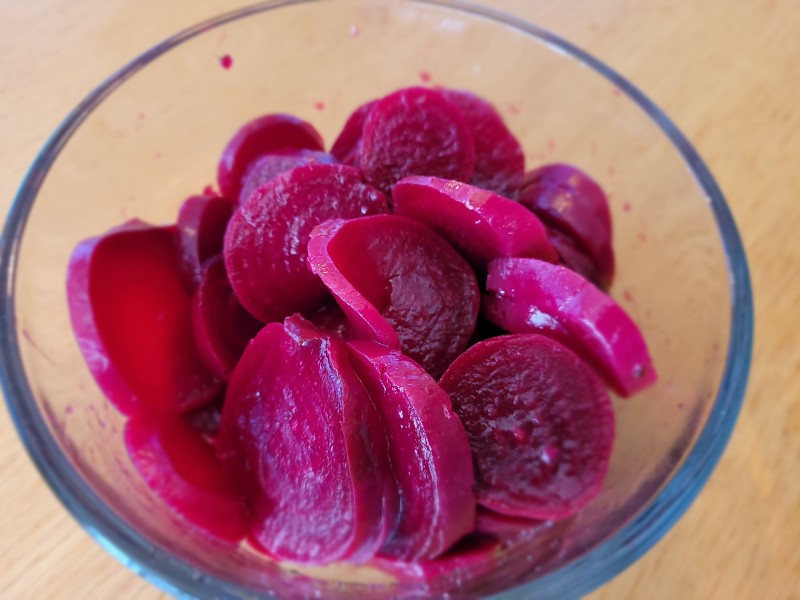
When I started growing vegetables on our small farm, beets were a veggie I didn't know much about. A Quebec guy raised in a francophone family, beetroot wasn't a common food for us.
At first, I found it tricky to use and a bit messy. But over time, I discovered recipes and methods that totally changed my perception of this veggie. In this article, I'll share how to prepare beets with minimal effort and why it deserves a spot in your kitchen.
Here is a video I recorded (in French) about beets as a complement to this article.
1. Why Choose Beets?
Beets are often-underestimated vegetable. They’re packed with nutritional benefits and can transform your dishes. Here are some reasons to add it to your diet.
Nutritional Properties of Beets
Beets are rich in antioxidants that help combat free radicals in your body. They’re excellent source of vitamins and minerals like A, C, iron, and potassium.
Plus, beetroot is known for its digestive benefits. It contains fibres that promote healthy bowel movements. Not bad for a little root veggie!
Common and Varied Uses
Beet's versatility is impressive. You can use it in multiple ways:
-
Raw: Grated or julienned, it adds beautiful colour to salads.
-
Cooked: Boiled, roasted, or in soups, it adapts to all preparations.
-
Juiced: An excellent way to quickly benefit from its nutrients.
Have you tried roasting beets with other vegetables? It's delicious! You can even mix them with dried fruits for a sweet touch.
Ready to try beets? Here are some tips for storing and preparing it.
2. Storing and Preparing Beets
Separating Leaves and Roots
When you get your beets, the first step is to separate the leaves from the root. Why's this important? The leaves keep drawing moisture from the root, which can lead to losing freshness. By separating these two parts, you're preserving the quality of your beets.
After separating the leaves, wash them carefully. You can store them in a plastic bag or airtight container. This helps maintain their moisture. Beet leaves can be cooked like kale or Swiss chard. A simple steam or sauté with onions and garlic can work wonders.
Preventing Moisture Loss
For the roots, the ideal is to store them in the fridge in a storage bin or plastic bag. It's crucial to wrap your veggies properly because it reduces moisture loss.
But remember, too much of anything isn't great - avoid washing the beets before storing, as too much water can promote mould. Using perforated plastic bags can help regulate humidity perfectly.
3. Creative Recipes with Beet Leaves
Beet leaves are often overlooked. But they're delicious and packed with nutrients. Why toss them when they can totally jazz up your dishes? Here are some creative ways to use them.
Sautéed Leaves
One of the simplest ways to prepare beet leaves is to sauté them. It takes just a few minutes. Here's how:
-
Wash the leaves thoroughly to remove any dirt
-
Heat a bit of oil in a pan
-
Add onions and garlic for extra flavour
-
Toss in the leaves and sauté for 2-3 minutes
-
For a sweet touch, throw in some dried fruits like raisins or cranberries
These sautés are perfect as a side or even a light main dish. Who knew leaves could be this tasty, eh?
Beet Leaf Salads
Beet leaves can also rock your salads. They add a crunchy texture and beautiful colour. Here's a simple idea:
-
Use 2-3 fresh beet leaves, washed well
-
Slice the stems finely and chop the leaves into strips
-
Add to spinach or mesclun mix
-
Toss in some crunchy veggies like carrots or radishes
-
Whip up a dressing with sunflower oil, balsamic vinegar, and a touch of honey
-
Sprinkle some nuts or seeds for extra crunch
Voilà! A delicious salad using an ingredient often forgotten in your culinary repertoire.
Next time you're prepping beets, remember their leaves. They deserve a spot on your plate!
4. Cooking Beets: Simple Methods
Cooking beets might seem intimidating, but I promise it's not rocket science. Whether you choose to boil, roast, or bake them, each method has its own charm. Let's break it down, eh?
1. Boiling: What to Keep in Mind
Boiling beets is a classic method. It's quick and straightforward. Here are a few things to remember:
-
Cooking Time: Small beets take about 30-45 minutes, while larger ones might need up to an hour
-
No Peeling Needed: Don't peel before boiling. This helps preserve flavour and nutrients
Once cooked, you can easily peel them. This also prevents staining your hands. Who doesn't love a simple hack?
2. Oven Roasting: Pros and Cons
Oven roasting is another fantastic option. It concentrates the flavours beautifully. Here's the scoop:
-
Pros: Roasted beets have a delicious texture and sweet taste. You can season them with spices for an unforgettable flavour
-
Cons: It takes more time. Budget about 60-90 minutes at 350°F for larger beets
Pro tip: Use aluminum foil when roasting. It helps retain moisture, speeds up cooking, and makes the beets tender. No need to peel beforehand - it's easier to remove the skin after cooking.
3. Roasting beets
For roasting beets, peel and cut them into uniform cubes. Add sunflower oil, salt, and your favourite spices (garlic, cumin, paprika, thyme, oregano - go wild!).
While roasting, mix beets with other root veggies like potatoes, carrots, squash, sweet potatoes, leeks, or parsnips. This creates a colourful dish bursting with flavours!
Whether you're boiling, roasting, or cooking in foil, beets have some tasty surprises in store. Experiment with cooking times to find your perfect texture. Each method has its charm - which one will become your go-to?
5. Beet Salads
Beets are often underestimated. They're incredibly versatile. From colourful salads to creamy soups, the possibilities are nearly endless. Here are some ideas to jazz up your cooking.
Best Cold Salad Recipes
Beet-based cold salads are a real treat. They add colour and flavour. Here are some of my favourites:
-
Beet and Feta Salad: Mix cooked beets, crumbled feta, nuts, and a balsamic vinaigrette
-
Beet and Apple Salad: Combine grated raw beets with apples for a sweet touch. Add nuts for crunch
-
Beetroot and Carrot Slaw: Mix grated beets and carrots with a simple vinaigrette for a vibrant, sweet salad
These recipes are quick and easy. Perfect for a light lunch or dinner side.
Ingredients for a Beet Salad
You'll need:
-
Fresh or cooked beets
-
Fruits like apples or pears
-
Dried fruits like raisins or cranberries
-
Fresh herbs like mint or parsley
-
Dressing: sunflower oil, balsamic vinegar, salt, and pepper
These ingredients play nicely together, creating a colourful and nutritious salad.

6. Other Beetroot Dishes: Soups and Stews
Beets aren't just for salads. They're great in soups and stews too. A creamy beet soup is an excellent choice. Cook beets with onions, butter, and broth, then blend for a silky-smooth texture.
In stews, beets add a natural sweetness. They pair well with other veggies and spices. Try roasting them with carrots and potatoes for a comforting, flavourful dish.
Bonus: Beet Varieties and Their Characteristics
Not all beets are created equal. Here are some varieties:
Classic Varieties
-
-
Colour: Deep red
-
Taste: Sweet and earthy
-
Use: Versatile, great for salads and cooking
-
-
-
Colour: Pink and white stripes
-
Taste: Milder, less pigmentation
-
Use: Perfect for salads, beautiful when sliced thin
-
-
-
Colour: Golden yellow
-
Taste: Sweeter, less tannic
-
Use: Great for those who find red beets too strong
-
Try growing these varieties in your garden, or get them from your family farmers in your basket program!
To learn more about our organic basket program, visit this page on our website or download our harvest calendar!
In conclusion, beets are a veggetable worth discovering. Whether in a salad, soup, or stew, they bring a unique touch to your dishes. Don't be afraid to experiment. You might be surprised by the flavours beets can offer. Enjoy their versatility and vibrant colour in your kitchen!
Frederic





Leave a comment (all fields required)